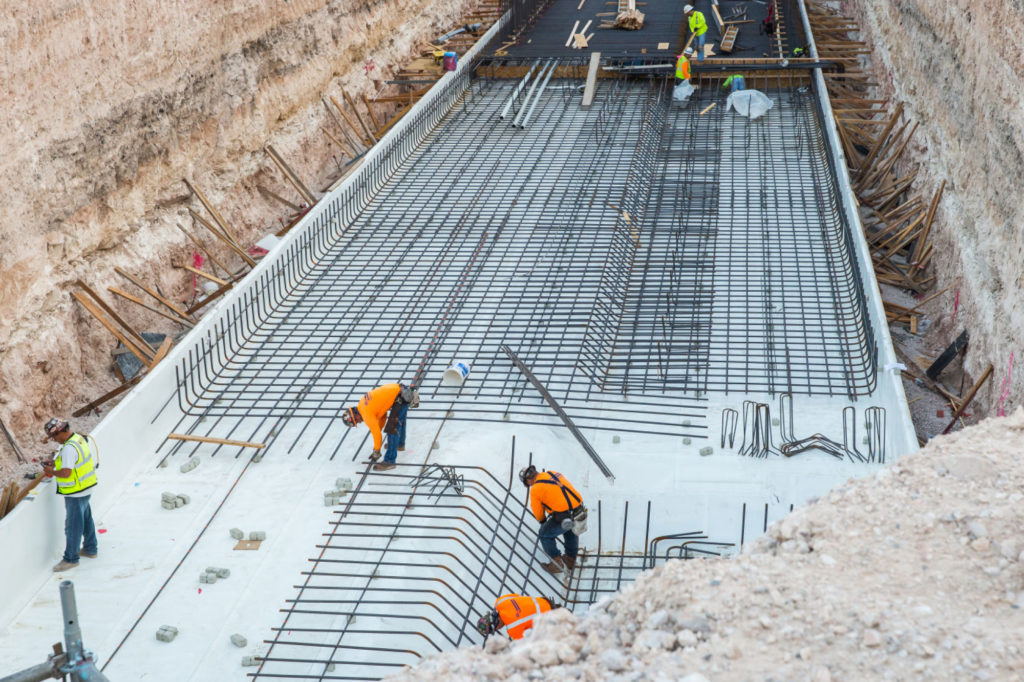
Reinforced concrete is one important component of skyscrapers. By 2000, only six other buildings in the world would surpass its height. It would remain the world's tallest office building for 41 years. In 1931, the Empire State Building rose in New York City like a 1,250-ft (381-m) exclamation point. Its steel skeleton rose from a foundation supported on concrete pillars that extended down to bedrock (a layer of solid rock strong enough to support the building), its frame was braced to resist expected wind forces, and its high-speed elevators provided both local and express service to its 60 floors. The 792-ft (242-m) tall Woolworth Building, erected in New York City in 1913, first combined all of the components of a true skyscraper. Was the 10-story Home Insurance Company Building, which was constructed in Chicago in 1885. The need for very thick walls was eliminated with the invention of steel-frame construction, in which a rigid steel skeleton supports the building's weight, and the outer walls are merely hung from the frame almost like curtains. A 16-story building constructed in Chicago in 1891 had walls 6 ft (1.8 m) thick at the base. Traditionally, the walls of a building supported the structure the taller the structure, the thicker the walls had to be.
SKYSCRAPER FOUNDATION DESIGN WINDOWS
During the 1920s and 1930s, skyscraper development was further spurred by invention of electric arc welding and fluorescent light bulbs (their bright light allowed people to work farther from windows and generated less heat than incandescent bulbs).

Among them were the ability to mass produce steel, the invention of safe and efficient elevators, and the development of improved techniques for measuring and analyzing structural loads and stresses. Several technological advances occurred in the late nineteenth century that combined to make skyscraper design and construction possible. Nonetheless, the decision to build a dramatically tall building is usually based not on economics, but on the desire to attract attention and gain prestige. On the other hand, developers in crowded cities must make the fullest possible use of limited amounts of available land. Developers must find tenants for huge amounts of space at one location for example, the Sears Tower encloses 4.5 million square feet (415,000 square meters). It is cheaper to build two half-height buildings than one very tall one. In some ways, super-tall buildings are not practical. The Sears Tower in Chicago boasts the highest occupied level the roof of its 110th story stands at 1,453 ft (443 m). The world's tallest occupied structure is the Petronas Twin Towers in Kuala Lumpur, Malaysia, which reach a height of 1,483 ft (452 m), including spires. The tallest freestanding structure in the world is the CN Tower in Toronto, Canada, which rises to a height of 1,815 ft (553 m) constructed to support a television antenna, the tower is not designed for human occupation, except for a restaurant and observation deck perched at 1,100 ft (335 m). Only 25 buildings around the world stand taller than 1,000 ft (300 m), counting their spires, but not antennas rising above them. At 102 stories, the Empire State Building's in New York occupied height reaches 1,224 ft (373 m), and its spire, which is the tapered portion atop a building's roof, rises another 230 ft (70 m). But it is widely accepted that a skyscraper fits buildings with 100 or more stories.


Others reserve the term for structures of at least 50 stories. Some observers apply the word "skyscraper" to buildings of at least 20 stories. Gottesdiener, a partner in the firm of Skidmore, Owings & Merrill, designers of numerous tall buildings including the Sears Tower in Chicago, Illinois, continued, "What is a skyscraper? It is anything that makes you stop, stand, crane your neck back, and look up." Gottesdiener told the Christian Science Monitor. "I don't think it is how many floors you have. There is no precise definition of how many stories or what height makes a building a skyscraper.


 0 kommentar(er)
0 kommentar(er)
